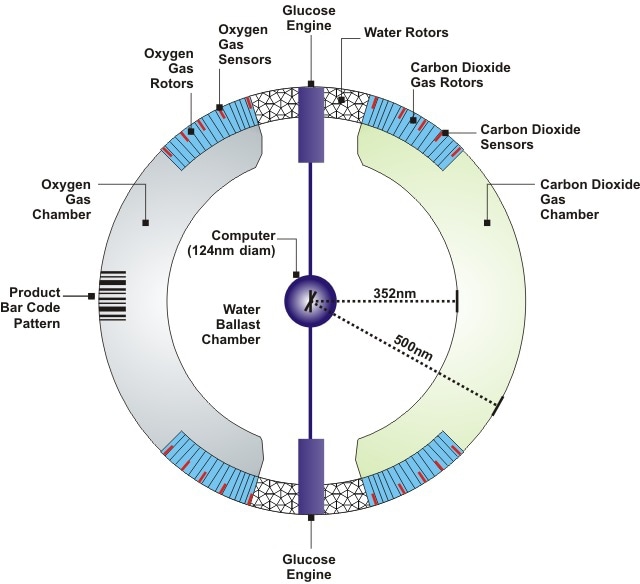A respirocyte is a hypothetical nanomachine capable of behaving like a red blood cell in humans. It could be used to augment or replace entirely our own red blood cells as a carrier of oxygen and carbon dioxide in the bloodstream.
The respirocyte was first proposed in the late 1990s by futurist Robert Freitas Jr. He published a paper detailing the design requirements for a respirocyte, which has become the standard reference point for all discussions about the technology, and indeed about many other kinds of medical nanorobots.
Respirocytes: An Artificial Red Blood Cell Replacement
Figure 1. An animated video showing an artists impression of respirocytes travelling down a blood vessel alongside natural red blood cells.
Proposed Design Features
The first concern in the design of a respirocyte is the overall size. Obviously the device must be small enough to pass unhindered through the bloodstream. In fact, Freitas' design is significantly smaller than a normal red blood cell (1 µm in diameter, as opposed to 6-8 µm), allowing the respirocytes to pass into the smallest capillaries, where red blood cells can normally get stuck and only move very slowly. This would allow for much more efficient delivery of oxygen to tissue than is possible with natural red cells alone.
Shell Construction
The outer shell of the respirocyte would be constructed out of a diamondoid material - this includes any crystal which has a structure similar to diamond, such as sapphire. The shell would most likely have to be built up from individual atoms or small units to ensure a flawless construction. The strength of a shell like this would allow the respirocyte to contain gases at incredibly high pressures, up to 100,000 atmospheres. With this capability, the device could hold 236 times more oxygen and carbon dioxide than a red blood cell.
Functionality
A working respirocyte would need the following components:
- Molecular rotors, built from around 100,000 atoms, to pump gases in and out of the pressurized storage chambers, and collect glucose for energy. These would be functionalized with selective binding sites, restricting them from pumping all but one type of molecule.
- A power generator of some sort, most likely similar in operation to a fuel cell, which would use glucose collected by a selective pump rotor to generate enough energy to power the device.
- Water ballast chambers, to control buoyancy.
- Various types of sensors, to determine the concentrations of oxygen and carbon dioxide in the vicinity, and monitor the pressure within the gas storage tanks.
- A tiny computer would be needed to interpret input from the sensors, and use the data to govern gas flow rates and power distribution. The computer would need only modest processing power, by the standard of normal sized computers, but the computing core and the data storage would have to fit inside a unit 124 nm across.
- Pressure transducers on the outside of the structure have been proposed as a receiver for programming instructions, sent by a physician via an encoded series of compression pulses.

Figure 2. Proposed design for a respirocyte. Whilst the devices are still hypothetical, some of the technologies required will soon be within reach.
Medical Applications
If and when our technology is advanced enough to build affordable respirocytes, the medical opportunities will clearly be limitless.
The most important applications will be to create an efficient, universal, long-lasting artificial blood-replacement fluid, for use in transfusions, and for first aid scenarios - if a person is drowning, choking, or suffering from any sort of asphyxia, a rapid injection of respirocytes will sustain them for long enough to reach medical help. This will also be of great use in heart attack cases, where keeping the patient alive for even a few minutes longer can mean survival.
Respirocytes could also be used to help treat respiratory diseases, such as pneumonia, and potentially provide a cure for chronic conditions like anaemia or asthma.
Sporting or Recreational Enhancement
Naturally, there will also be some interest in using the technology to generally enhance the capabilities of healthy people.
Using respirocytes to augment normal blood could allow divers to stay underwater for long periods of time without breathing, climbers to reach high altitudes without the need for oxygen tanks, and let athletes sustain a sprint for minutes rather than seconds.
Athletic competitions like the Olympics would have to run strict tests for respirocytes, as well as performance-improving drugs, otherwise the athletes with no enhancements would be at a significant disadvantage!
Conclusion
The technology required to build a respirocyte is still very much in the theoretical stage. Whilst it seems likely that Freitas' design will become practical at some point, it will be many years before they are seen in the world of medicine. Even when we can build the devices, a great deal of safety testing will be required, to make sure that immune responses and toxicity are properly managed. There may also be issues with the long-term stress put on the other systems in the body when the circulatory system is given these literally super-human powers.
A nearer-term goal, however, may be to build a prototype. The process would be prohibitively expensive with our current technology, and several key components are missing (nanocomputation, power source, etc.), but at the current rate that nanotechnology is developing, it will not be long before we can consider constructing structures of this complexity on such a small scale.
References